Penetration Performance of Steel Cylinders in Sand Foundations
Abstract
:1. Introduction
2. Materials and Methods
2.1. Steel Cylinder Models
2.2. Soil Preparation
2.3. Test Setup and Device
2.4. Test Program
3. Finite Element Modelling
3.1. Model Description
3.2. Soil Parameters
3.3. Mesh Sensitivity Analysis
4. Results and Discussion
4.1. Model Test Results
4.2. Verification of Numerical Model Results
4.3. Influence of Wall Thickness on Soil Flow
4.4. Influence of Wall Thickness on the Soil Heave in the Cylinder
5. Conclusions
- (1)
- It can be seen from the test results that the penetration force of a steel cylinder increases gradually with increasing penetration depth, and the influence of wall thickness on the penetration force increases gradually. We established the relationship between the penetration resistance of steel cylinders and the penetration depth under different wall thicknesses. Through the relationship between the two, it can be seen that as the penetration depth increases, the rate of increase in penetration resistance increases.
- (2)
- From the numerical simulation results, it can be seen that wall thickness has a significant impact on the uplift of soil. With an increase in wall thickness of a steel cylinder, the uplift height of the soil inside the steel cylinder gradually increases. When the wall thickness increases from 1 mm to 4 mm, the uplift height of the soil inside the steel cylinder increases 2.6 times.
- (3)
- In this paper, the penetration process of steel cylinders in sandy soil foundations was studied through indoor tests and numerical simulations, and the penetration force and soil uplift during the penetration process of steel cylinders were studied. According to the comparative analysis of the two, the uplift of soil in the barrel increases with an increase in wall thickness. The operative volume ratio of the soil in the bucket is calculated by means of a formula, and it was found that it has a power function relationship with wall thickness. The research results can provide a reference for the application of penetration force during the penetration process of steel cylinders.
Author Contributions
Funding
Institutional Review Board Statement
Informed Consent Statement
Data Availability Statement
Acknowledgments
Conflicts of Interest
References
- Sparrevik, P. Suction Pile Technology and Installation in Deep Waters. In Proceedings of the Annual Offshore Technology Conference, Houston, TX, USA, 6–9 May 2002; pp. 2171–2179. [Google Scholar]
- Koh, K.X.; Hossain, M.S.; Kim, Y. Installation and Monotonic Pullout of a Suction Caisson Anchor in Calcareous Silt. J. Geotech. Geoenviron. Eng. 2017, 143, 04016098. [Google Scholar] [CrossRef]
- Andersen, K.H.; Murff, J.D.; Randolph, M.F.; Clukey, E.; Erbrich, C. Suction anchors for deepwater applications. In Frontiers in Offshore Geotechnics, ISFOG 2005, Proceedings of the 1st International Symposium on Frontiers in Offshore Geotechnics, Perth, WA, Australia, 19–21 September 2005; ISFOG: Perth, Australia, 2005; pp. 3–30. [Google Scholar]
- Zhang, J.H.; Zhang, L.M.; Lu, X.B. Centrifuge modeling of suction bucket foundations for platforms under ice-sheet-induced cyclic lateral loadings. Ocean Eng. 2007, 34, 1069–1079. [Google Scholar] [CrossRef]
- Zhang, P.; Ding, H. Bearing capacity of the bucket spudcan foundation for offshore jack-up drilling platforms. Pet. Explor. Dev. 2011, 38, 237–242. [Google Scholar] [CrossRef]
- Villalobos, F.A.; Byrne, B.W.; Houlsby, G.T. Model testing of suction caissons in clay subjected to vertical loading. Appl. Ocean Res. 2010, 32, 414–424. [Google Scholar] [CrossRef]
- Jijian, L.; Hongyan, D.; Puyang, Z.; Rui, Y. Design of Large-Scale Prestressing Bucket Foundation for Offshore Wind Turbines. Trans. Tianjin Univ. 2012, 18, 79–84. [Google Scholar]
- Achmus, M.; Akdag, C.T.; Thieken, K. Load-bearing behavior of suction bucket foundations in sand. Appl. Ocean Res. 2013, 43, 157–165. [Google Scholar] [CrossRef]
- Byrne, B.; Houlsby, G.; Martin, C.; Fish, P. Suction caisson foundations for offshore wind turbines. Wind Eng. 2002, 26, 145–155. [Google Scholar] [CrossRef]
- Gavin, K.; Igoe, D.; Doherty, P. Piles for offshore wind turbines: A state-of-the-art review. Proc. Inst. Civ. Eng. Geotech. Eng. 2011, 164, 245–256. [Google Scholar] [CrossRef]
- Houlsby, G.T.; Kelly, R.B.; Huxtable, J.; Byrne, B.W. Field trials of suction caissons in sand for offshore wind turbine foundations. Geotechnique 2005, 55, 287–296. [Google Scholar] [CrossRef]
- Andersen, K.H.; Jostad, H.P. Foundation design of skirted foundations and anchors in clay. In Proceedings of the Annual Offshore Technology Conference, Houston, TX, USA, 3–6 May 1999; Volume 1, pp. 383–392. [Google Scholar]
- Randolph, M.F.; Gaudin, C.; Gourvenec, S.M.; White, D.J.; Boylan, N.; Cassidy, M.J. Recent advances in offshore geotechnics for deep water oil and gas developments. Ocean Eng. 2011, 38, 818–834. [Google Scholar] [CrossRef]
- Andresen, L.; Jostad, H.P.; Andersen, K.H. Finite Element Analyses Applied in Design of Foundations and Anchors for Offshore Structures. Int. J. Geomech. 2011, 11, 417–430. [Google Scholar] [CrossRef]
- Chu, J.; Yan, S.W.; Li, W. Innovative methods for dike construction-An overview. Geotext. Geomembr. 2012, 30, 35–42. [Google Scholar] [CrossRef]
- Chen, W.; Zhou, H.; Randolph, M.F. Effect of Installation Method on External Shaft Friction of Caissons in Soft Clay. J. Geotech. Geoenviron. Eng. 2009, 135, 605–615. [Google Scholar] [CrossRef]
- Chen, F.; Lian, J.; Wang, H.; Liu, F.; Wang, H.; Zhao, Y. Large-scale experimental investigation of the installation of suction caissons in silt sand. Appl. Ocean Res. 2016, 60, 109–120. [Google Scholar] [CrossRef]
- Zhang, P.; Guo, Y.; Liu, Y.; Ding, H. Experimental study on installation of hybrid bucket foundations for offshore wind turbines in silty clay. Ocean Eng. 2016, 114, 87–100. [Google Scholar] [CrossRef]
- Stapelfeldt, M.; Bienen, B.; Grabe, J. The influence of the drainage regime on the installation and the response to vertical cyclic loading of suction caissons in dense sand. Ocean Eng. 2020, 215, 107105. [Google Scholar] [CrossRef]
- Guo, W.; Chu, J. Suction caisson installation in shallow water: Model tests and prediction. In Proceedings of the 18th International Conference on Soil Mechanics and Geotechnical Engineering: Challenges and Innovations in Geotechnics, ICSMGE, Paris, France, 2–6 September 2013; Volume 3, pp. 1999–2002. [Google Scholar]
- Gaudin, C.; O’Loughlin, C.D.; Hossain, M.S.; Randolph, M.F.; Colliat, J.L. Installation of suction caissons in Gulf of Guinea clay. In Physical Modelling in Geotechnics, Proceedings of the 8th International Conference on Physical Modelling in Geotechnics 2014, ICPMG, Perth, Australia, 14–17 January 2014; CRC Press: Boca Raton, FL, USA, 2014; Volume 1, pp. 493–499. [Google Scholar]
- Zhu, X.J.; Li, W.S.; Fei, K. Jacking penetration resistance and mechanical characteristics of bucket foundations in sand. Bull. Eng. Geol. Environ. 2020, 79, 1–10. [Google Scholar] [CrossRef]
- Houlsby, G.T.; Byrne, B.W. Design procedures for installation of suction caissons in clay and other materials. Proc. Inst. Civ. Eng. Geotech. Eng. 2005, 158, 75–82. [Google Scholar] [CrossRef]
- Jin, Z.; Yin, Z.Y.; Kotronis, P.; Jin, Y.F. Numerical Analysis of a Suction Bucket Penetrating in Sand with a Combined Lagrangian-SPH Approach. Procedia Eng. 2017, 175, 189–196. [Google Scholar] [CrossRef]
- Zhou, H.; Randolph, M.F. Large deformation analysis of suction caisson installation in clay. Can. Geotech. J. 2006, 43, 1344–1357. [Google Scholar] [CrossRef]
- Harireche, O.; Naqash, M.T.; Farooq, Q.U. A full numerical model for the installation analysis of suction caissons in sand. Ocean Eng. 2021, 234, 109173. [Google Scholar] [CrossRef]
- Harireche, O.; Mehravar, M.; Alani, A.M. Soil conditions and bounds to suction during the installation of caisson foundations in sand. Ocean Eng. 2014, 88, 164–173. [Google Scholar] [CrossRef]
- Hu, Y.; Randolph, M.F. A practical numerical approach for large deformation problems in soil. Int. J. Numer. Anal. Methods Geomech. 1998, 22, 327–350. [Google Scholar] [CrossRef]
- Vásquez, L.F.G.; Maniar, D.R.; Tassoulas, J.L. Installation and Axial Pullout of Suction Caissons: Numerical Modeling. J. Geotech. Geoenviron. Eng. 2010, 136, 1137–1147. [Google Scholar] [CrossRef]
- Maniar, D.R.; Vásquez, L.F.G.; Tassoulas, J.L. Installation and pullout of suction caissons: Finite-element simulation. In Proceedings of the OMAE03 22nd International Conference on Offshore Mechanics and Arctic Engineering, Cancun, Mexico, 8–13 June 2003; pp. 1–2. [Google Scholar]
- Senders, M.; Randolph, M.F. CPT-Based Method for the Installation of Suction Caissons in Sand. J. Geotech. Geoenviron. Eng. 2009, 135, 14–25. [Google Scholar] [CrossRef]
- Klinkvort, R.T.; Sturm, H.; Andersen, K.H. Penetration Model for Installation of Skirted Foundations in Layered Soils. J. Geotech. Geoenviron. Eng. 2019, 145, 04019085. [Google Scholar] [CrossRef]
- Grecu, S.; Ibsen, L.B.; Barari, A. Winkler springs for axial response of suction bucket foundations in cohesionless soil. Soils Found. 2021, 61, 64–79. [Google Scholar] [CrossRef]
- Niu, Q.L.; Song, G.; Cui, S.Y.; Kou, B.B.; Tian, Z.Y.; Tian, Y.Y. Calculation and analysis of penetration force on offshore suction bucket jacket foundation. Drill. Eng. 2023, 50, 31–38. [Google Scholar]
- Systemes, D. Abaqus Analysis Users’ Manual; Simula Corp: Providence, RI, USA, 2010. [Google Scholar]
- Xiao, Z.; Fu, D.; Zhou, Z.; Lu, Y.; Yan, Y. Effects of strain softening on the penetration resistance of offshore bucket foundation in nonhomogeneous clay. Ocean Eng. 2019, 193, 106594. [Google Scholar] [CrossRef]


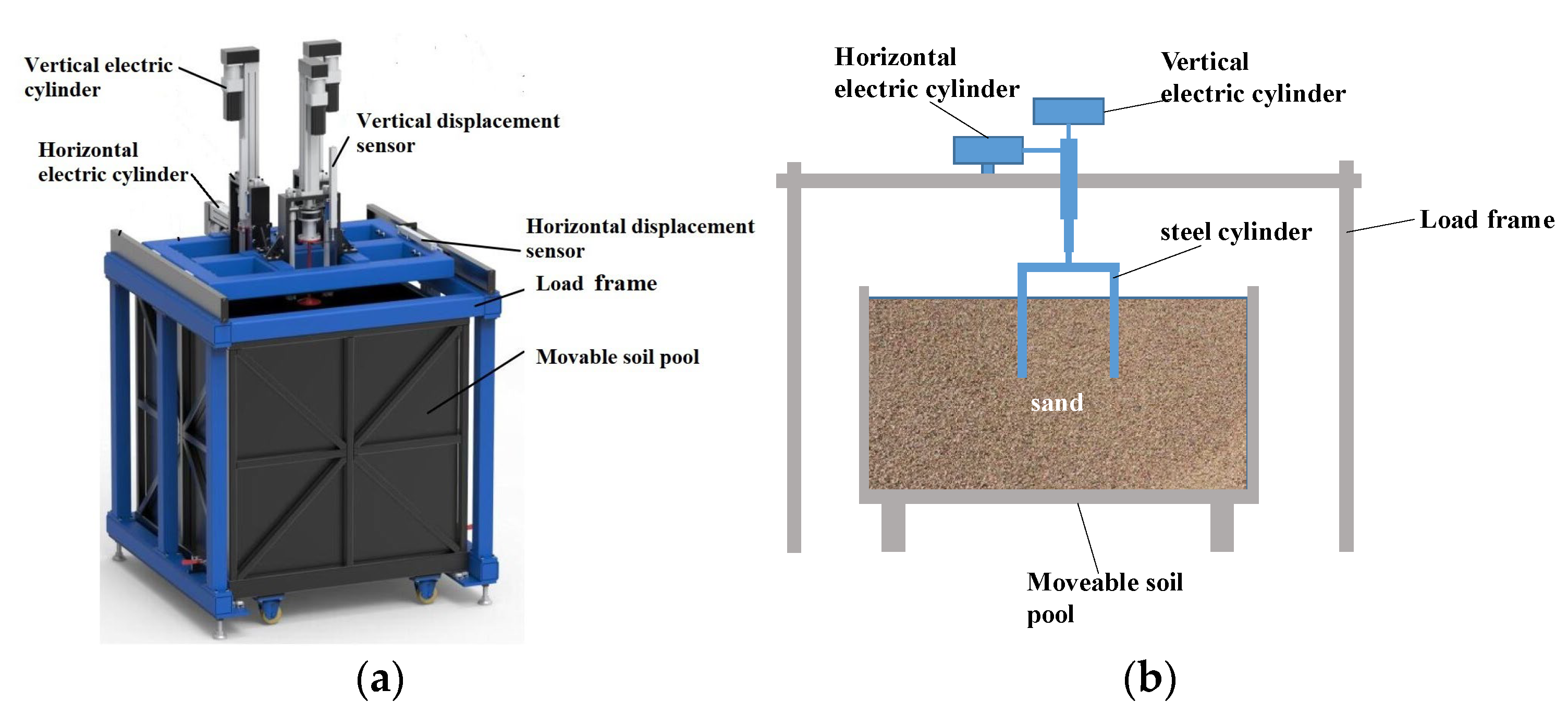
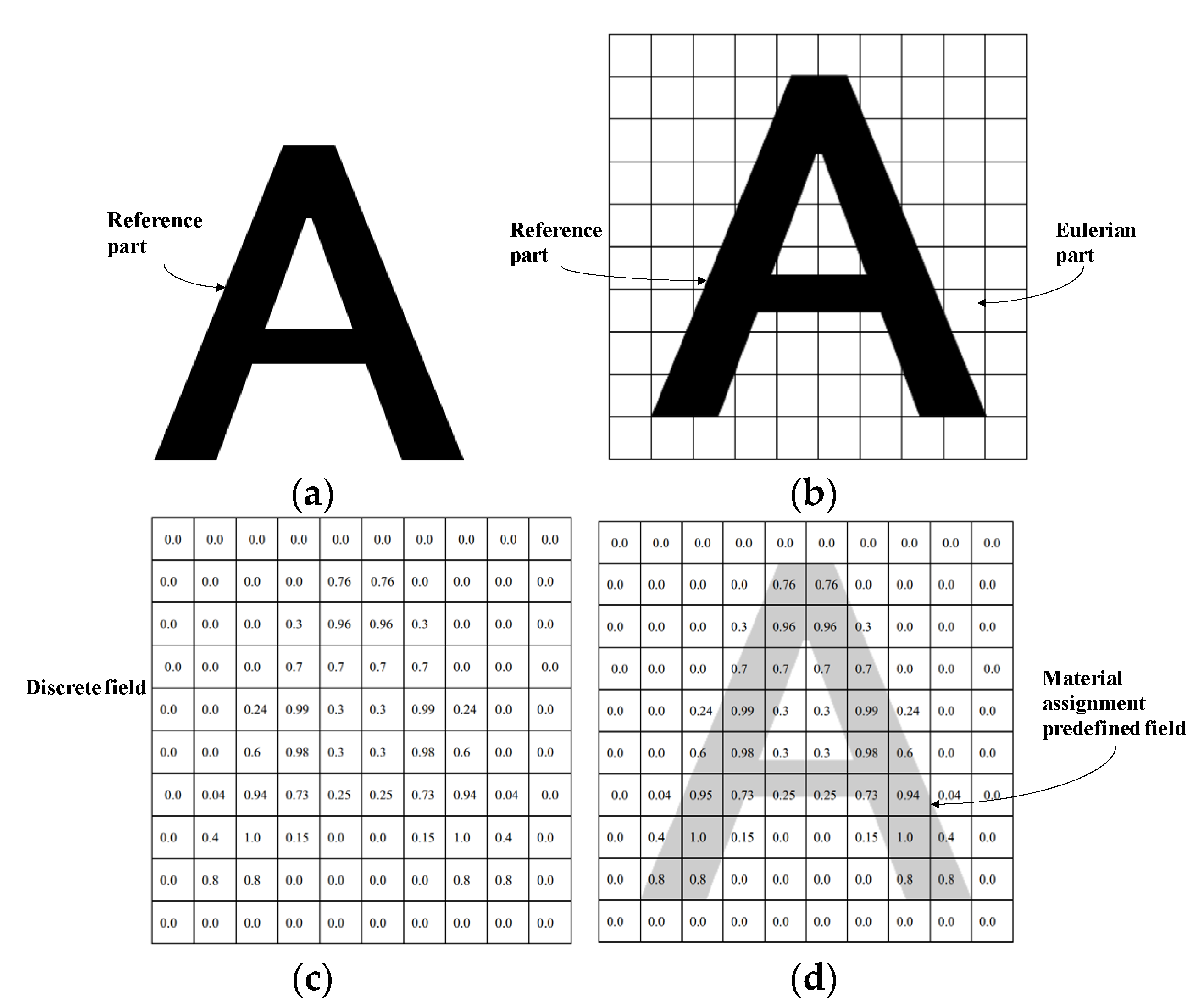



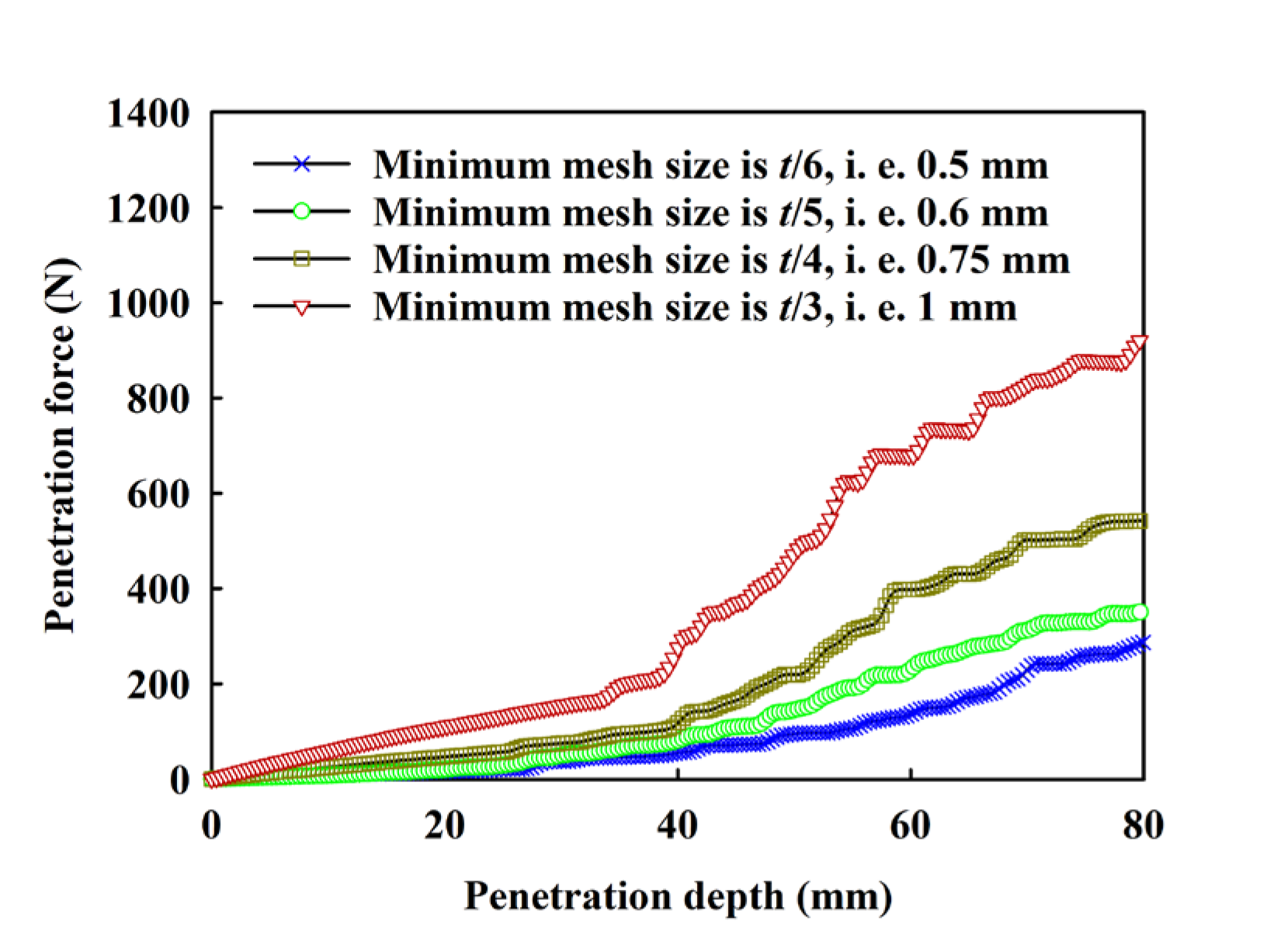

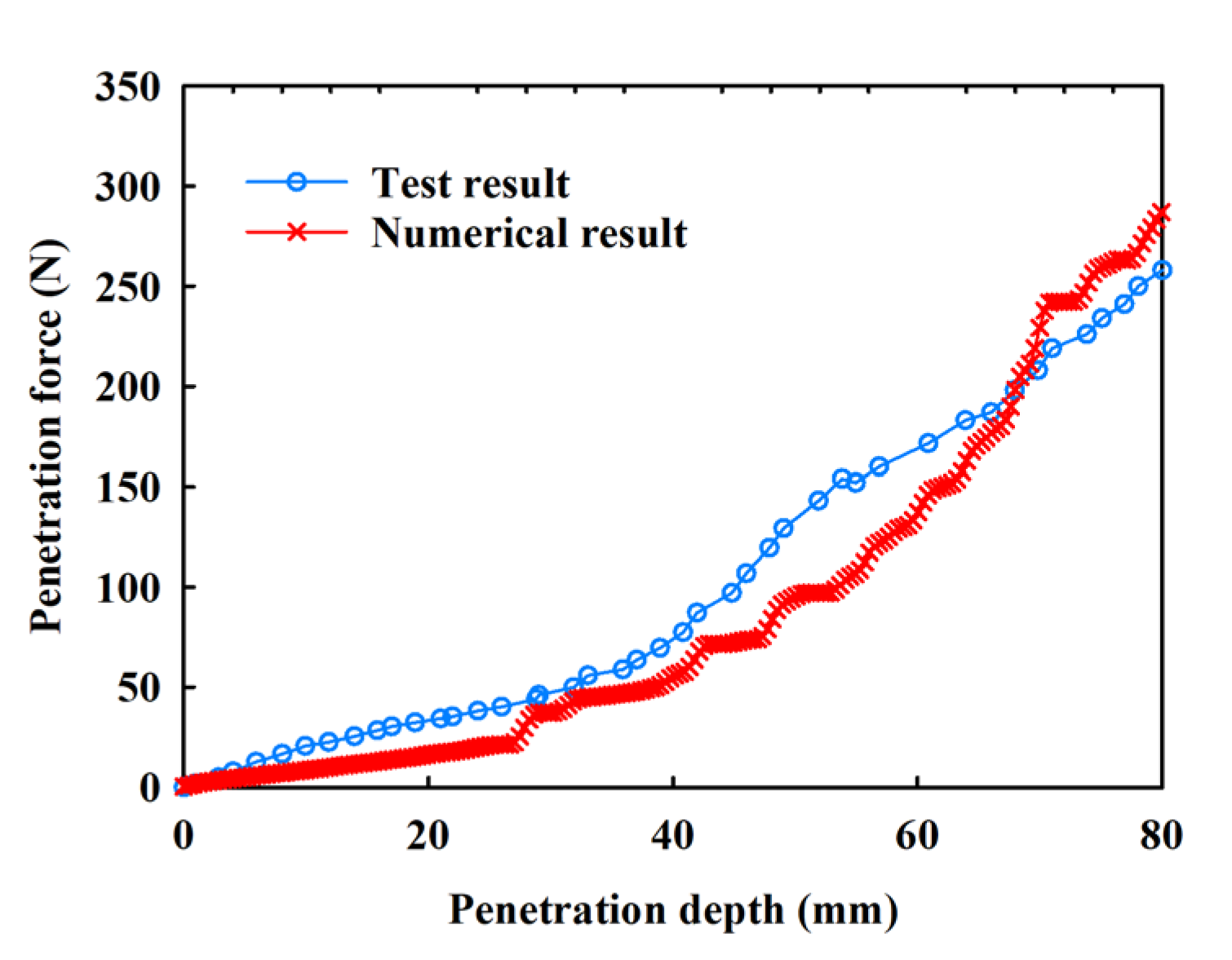

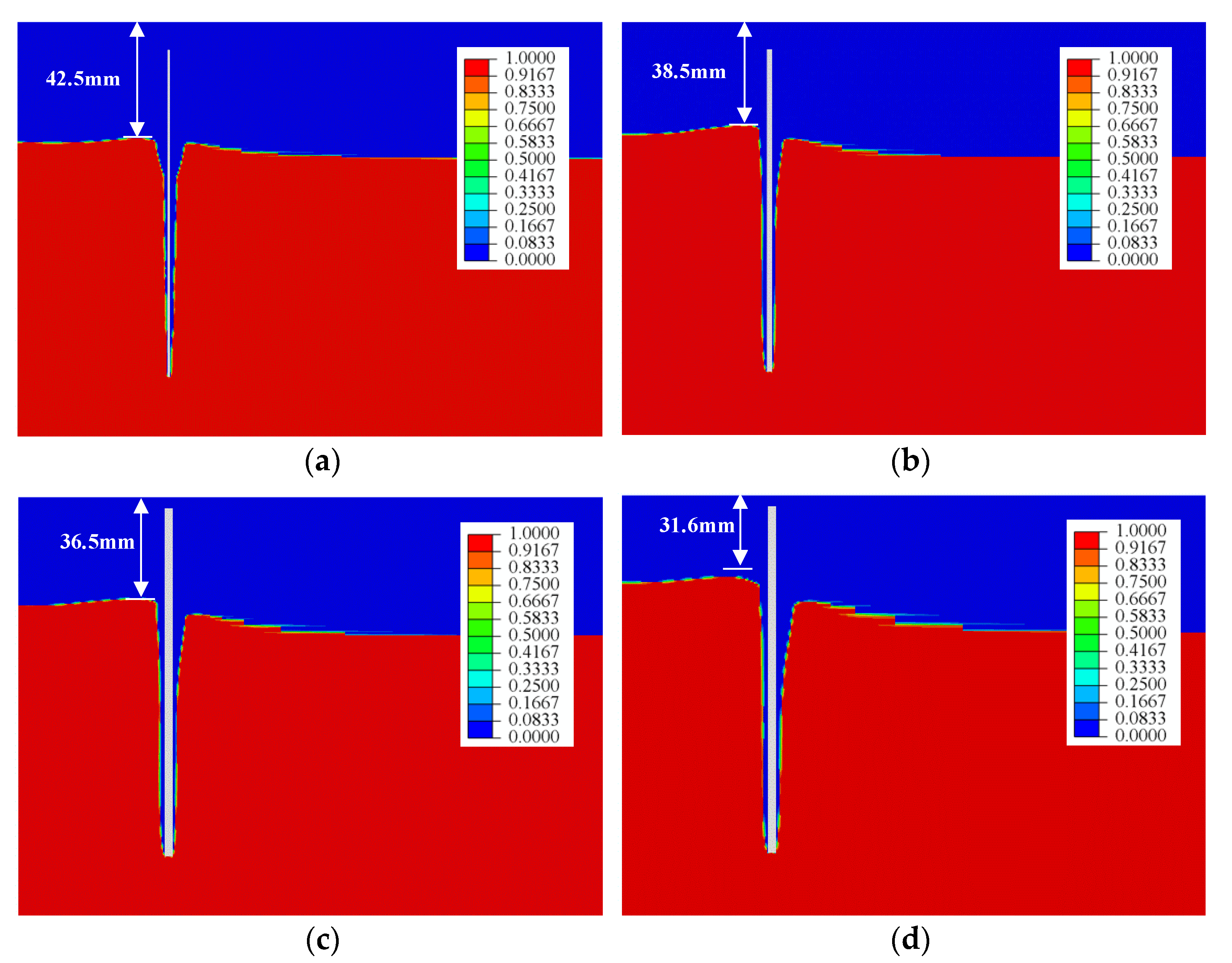
| Wall Thickness t/mm | e | f | R2 |
|---|---|---|---|
| 1 | 0.0215 | 0.0353 | 0.9804 |
| 2 | 0.0294 | 0.3516 | 0.9891 |
| 3 | 0.0307 | 0.8002 | 0.9919 |
| 4 | 0.0747 | 0.5594 | 0.9974 |
Disclaimer/Publisher’s Note: The statements, opinions and data contained in all publications are solely those of the individual author(s) and contributor(s) and not of MDPI and/or the editor(s). MDPI and/or the editor(s) disclaim responsibility for any injury to people or property resulting from any ideas, methods, instructions or products referred to in the content. |
© 2023 by the authors. Licensee MDPI, Basel, Switzerland. This article is an open access article distributed under the terms and conditions of the Creative Commons Attribution (CC BY) license (https://creativecommons.org/licenses/by/4.0/).
Share and Cite
Xu, W.; Ruan, H.; Jiang, P. Penetration Performance of Steel Cylinders in Sand Foundations. Appl. Sci. 2023, 13, 9417. https://doi.org/10.3390/app13169417
Xu W, Ruan H, Jiang P. Penetration Performance of Steel Cylinders in Sand Foundations. Applied Sciences. 2023; 13(16):9417. https://doi.org/10.3390/app13169417
Chicago/Turabian StyleXu, Weiqiang, Huaining Ruan, and Pengming Jiang. 2023. "Penetration Performance of Steel Cylinders in Sand Foundations" Applied Sciences 13, no. 16: 9417. https://doi.org/10.3390/app13169417
APA StyleXu, W., Ruan, H., & Jiang, P. (2023). Penetration Performance of Steel Cylinders in Sand Foundations. Applied Sciences, 13(16), 9417. https://doi.org/10.3390/app13169417





